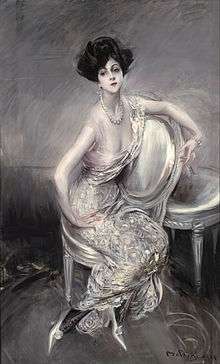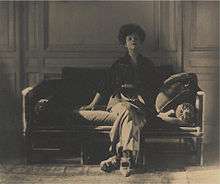Rita de Acosta Lydig


Rita Lydig (born Rita Hernandez de Alba de Acosta, October 1875[1]– October 27, 1929) was an American socialite regarded as "the most picturesque woman in America." She was photographed by Adolf de Meyer, Edward Steichen, and Gertrude Käsebier, sculpted in alabaster by Malvina Hoffman, and was painted by Giovanni Boldini and John Singer Sargent, among others.[2][3] She also wrote one novel, Tragic Mansions (Boni & Liveright, 1927), under the name Mrs Philip Lydig, a society melodrama described as "emotionally moving and appealing" by The New York Times.
Birth and family
Rita de Acosta was born in New York City in 1875 to Ricardo de Acosta, a steamship-line executive of Cuban descent, and a Spanish mother, Micaela Hernández de Alba y de Alba, reputedly a relation of the Dukes of Alba. She had seven siblings: Joaquín, Enrique, Ricardo, Mercedes, Aida, Maria, and Ángela.[4]
Her sister Mercedes de Acosta, a lover of movie star Greta Garbo, was an author, a scriptwriter, and social critic. Another sister, Aida de Acosta, became the first female to fly a powered aircraft solo.
Personal life
Rita de Acosta was married twice:
- On January 3, 1895,[5] aged 19, she became the first wife of William Earl Dodge Stokes, a multimillionaire with whom she had a son, William Earl Dodge Stokes Jr, born January 5, 1896.[6] The marriage was unhappy, reportedly due to Stokes's temper and physical cruelty, and when it was dissolved by divorce in 1900, she received a settlement of nearly two million dollars, a record for the time. In February 1922 she testified in court against Stokes, then going through an acrimonious divorce from his second wife, stating that he used to beat her during their marriage.[7]
- In 1902 she married Captain Philip M. Lydig, a retired officer in the United States Army.[8] They separated in 1914 and divorced in 1919.[9]
In 1921 Lydig announced her engagement to Reverend Percy Stickney Grant, rector of the Church of the Ascension. Their wedding plans were broken off in 1924 when Bishop William Manning refused to authorise the marriage, citing Lydig being a divorcée with two living former husbands. Rev. Grant died shortly afterwards, leaving his personal fortune to the woman he had hoped to marry, and Lydig spent large sums of money on fashion, art, furniture, and other objects to overcome her grief.[10] Heavily in debt, she was forced to sell her Washington Square home and its contents, was declared bankrupt, and died of pernicious anaemia at the Gotham Hotel shortly after, at the age of 54.[10][11]
Lydig is buried with her mother and sister Mercedes[8] at Trinity Church Cemetery in lower Manhattan, New York City.
Influence on art and fashion
Famous for her extravagant lifestyle, '...Rita was equally welcomed in Paris, where she spent parts of each year. She would arrive at the Ritz with a hairdresser, masseuse, chauffeur, secretary, maid,... and forty Louis Vuitton trunks... In Paris, she joined ranks with musicians, artists, intellectuals, and philosophers such as Rodin, Eleonora Duse, Yvette Guilbert etc... Impressed by Rita's innate creative spirit, Isabella Stewart Gardner, the great collector and creator of the Gardner museum in Boston, once asked their mutual friend, John Singer Sargent, why Rita had never expressed herself artistically. "Why should she?" Sargent answered, "She herself is art."[12]
Lydig lived in New York, Paris and London, and counted Edgar Degas, Auguste Rodin, Leo Tolstoy, Sarah Bernhardt, Ethel Barrymore and Claude Debussy among her friends.[10] She also supported the suffragette cause.[13][14]
Her personal wardrobe became the basis for the start of the Costume Institute at the Metropolitan Museum of Art.[3]
References
- ↑ MRS. W.E.D. STOKES SUES; Secrecy Observed by Counsel in Her Action for Divorce 'The New York Times' April 5, 1900
- ↑ "Spirited Masterpiece: Rita de Acosta Lydig by Giovanni Boldini" by Bill Rau on Artfix
- 1 2 Mercedes de Acosta by Robert A. Schanke
- ↑ Robert A. Schanke, That Furious Lesbian: The Story of Mercedes de Acosta, Southern Illinois University, 2003.
- ↑ WEDDING OF MISS ACOSTA; Married to W.E.D. Stokes by Archbishop Corrigan 'The New York Times' January 4, 1895
- ↑ STOKES DIVORCE DECREE; Presented in Supreme Court by Mrs. Stokes's Counsel 'The New York Times' April 28, 1900
- ↑ 'The New York Times' February 4, 1922
- 1 2 "Rita de Acosta". Retrieved 2006-06-01.
- ↑ 'The New York Times' June 18, 1919
- 1 2 3 Lydig on the Shepherd Gallery website
- ↑ “Mrs. Rita Lydig Dies Unexpectedly at 50” 'The New York Times' October 20, 1929
- ↑ 'The Power of Style: The Women Who Defined the Art of Living Well' by Annette Tapert Published by Crown (1994)
- ↑ SOCIETY WOMEN IN POSES FOR SUFFRAGE 'The New York Times' November 8, 1910
- ↑ COLBY COMES OUT FOR SUFFRAGETTES 'The New York Times' December 17, 1909
| Wikimedia Commons has media related to Rita de Acosta Lydig. |
External links
- Sotheby's Catalogue 2007
- Lydig in 'The New York Times' February 4, 1922
- LYDIG COLLECTION SOLD FOR $362,555; Art Treasures Scattered at Two Sales to Dealers and Private Collectors 'The New York Times' April 5, 1913
- Death notice in Time Magazine October 28, 1929
- The Building of the Upper West Side 2005
- Documenting the Gilded Age: New York City Exhibitions at the Turn of the 20th Century A New York Art Resources Consortium project. Includes exhibition catalog of Ignacio Zuloaga, cablegram, invitations, and handwritten scheme for the arrangement of paintings in the Brooklyn Museum exhibition.